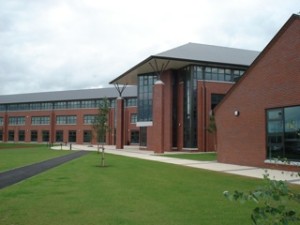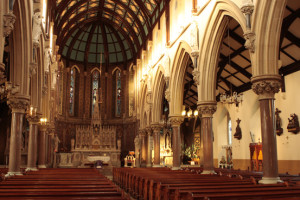READ A HISTORY AS PUBLISHED ON THE ABBEY CBS WEBSITE.
THE ABBEY GRAMMAR
The Christian Brothers first came to Newry in 1851 and the school derives its name from the celebrated Cistercian Abbey founded on the same site by St. Malachy in 1144.
In its history, the school had been located at several sites around Newry, including Chapel Street, Kilmorey Street, the Carstands at Margaret Street and the Mall, then on to Abbey Yard and Courtenay Hill.
In January 2010 the Abbey moved into the brand new purpose-built school on the outskirts of Newry. It is accessed from the Mourne Country roundabout to the north of the city on the Belfast Road . The grounds back on to the Sacred Heart Grammar School.
ST COLMAN’S ABBEY PRIMARY
CELEBRATION OF 75 YEARS ON THE PRESENT SITE
(24th May 2013)
The day began with Mass in the Cathedral at 10.30 followed by dinner in the Canal Court Hotel.
The Diamond Jubilee Mass was concelebrated by ten priests,
Canon Francis Brown (Administrator of the Parish),
Father Stanislaw Hajkowski (School Chaplain),
Father Colum Wright PP (Past Pupil),
Father John Byrne CC (Past Pupil),
Father Desmond Mooney CC (Past Pupil),
Father Martin Hughes CC (Past Pupil),
Father Desmond Loughran CC (Past Pupil),
Father David Rocks OP (Past Pupil),
Father Stephen Tumilty OP (Past Pupil)
and Father Raymond Murtagh SPS (Past Pupil).
Mr Danny O’Neill was the organist.
Staff , past staff, pupils and past pupils very ably contributed to the liturgy with their music, readings, prayers, reflections and Offertory Procession.
A SHORT HISTORY
Mr Anthony Russell
(Past Pupil)
By the 7th June 1938, when the Abbey Public Elementary School opened, the Christian Brothers had been providing education, meals and clothing for the less well of boys in Newry, in a variety of buildings, for eighty seven years – years that had seen the town stagnate; its mills and inland canal stuttering towards closure, Housing on the eastern hill and on the valley floor was high density; few had running water.
Although, from 1865, the architect Barre’s Carstands School in Margaret Street, since demolished, was a purpose built and much admired build, it was crowded and inadequate. Therefore, from 1918, following all schools being closed because of the flu pandemic, pupils in years one and two went to Kilmorey Street, years three, four, and five to the Carstands and year six to Abbey Yard. This arrangement, and its associated buildings, was unsatisfactory, but in 1930 new legislation allowed Catholics to apply to the Northern Ireland Ministry of Education for help in building schools.
In 1938 the brightly decorated brick building on Courtney Hill had 15 classrooms, two specialist rooms, an assembly hall, a covered basement play area and, remarkably, given previous conditions, central heating. It could accommodate 800 pupils, making it one of the largest elementary schools in the country.
Ten years later, the 1947 Education Act changed its status and it became a primary school with the emphasis on the educational and social opportunities offered by the new Qualifying Examination. Until now infant boys went to St Joseph’s and St Clare’s convent schools. This changed in 1964 and by 1969, with the provision of temporary classrooms and the use of rooms in the old Abbey Yard grammar school, the roll had risen to 1,080. However, the growth of well equipped housing estates on the periphery of the town, saw the opening of St Patrick’s, St Malachy’s and St Ronan’s primary schools with the consequent fall in the Abbey’s numbers.
Three innovations have changed the character of the Abbey.
- Going back to the Carstands school, male lay teachers had always taught alongside the Brothers but in 1959 the first of many female teachers were employed. They now form the majority of the staff.
- In 1976 the Educational Centre for Physically Disabled opened its doors to boys and girls. There was a primary class, ages 4 to 11, and senior class, ages 11 to 19. Today, only the primary class remains.
- With the Millenium, the St Colman’s and St Clare’s Nursery opened beside the ECPD.
With the exceptions of the ECPD and Nursery, both well integrated into the life of the Abbey, the school is once again comfortably and happily contained within the 1938 building. It has served pupils and teachers well over this last 75 years.
Although the Brothers have left the town and the multi-ethnic, technologically aware pupils of today look very different from the sometimes barefoot, sometimes hungry, sometimes cold pupils of the 1930s, the values of Edmund Rice and the ethos of the Christian Brothers still prepare them for the challenge of a rapidly changing world.

